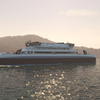When two-year-old Janet McAllister christened her namesake in New York last month — the 5,000-hp, Eastern Shipbuilding-built Janet M. McAllister — a resurgence of maritime pride was evident at the South Street Seaport that had been missing from New York for years. The symbolism of a new generation from one of America's great maritime families inaugurating the most powerful tugboat in arguably the country’s most historic harbor was not lost. The event drew a healthy crowd of industry personnel, people with a vested interest in the boat or the storied towing company. But just as interesting was the throng of New York natives and tourist fixated on the event, as the vessel was put through her paces.
For an industry that is often portrayed as low-tech and slow to change, one would have been hard-pressed to confirm that opinion on Monday, July 23 at Pier 16. Janet M. McAllister, with her full complement of advanced machinery and electronics, including EMD diesel engines and Schottel steerable Kort Nozzle Rudder Propellers, put on an impressive display that included a number of rapid fire turns, twists and circles, moves which officials admit would not be needed 90 percent of the time, but maneuverability that would be invaluable in a time of need.
The event hammered home the fact that the industry has changed in a very fundamental manner, and that companies seeking to survive and prosper must strive to develop, manufacture and incorporate higher levels of technologically advanced marine equipment and systems.
Marine technology is omnipresent in our pages, but this month seemingly more so than others, starting with David Tinsley's 'Investment in Design' piece on page 8. "Reefership within a Containership" highlights a new ship design that demonstrates the need for ever evolving ship design and construction to meet changing markets. A side piece on a new ferry design for the Norwegian fjords discusses a design which is "… economical and environmentally compatible …," which has seemingly become a benchmark for any vessel design today.
The U.S. Report starts with an update from Senior Editor Regina Ciardiello on the status of the Bollinger Incat USA endeavor to build high speed aluminum ferries in the U.S. Most of you who have followed the 'Australian Invasion' will be interested to know that both Incat and it's counterpart, Austal — which has established an entirely new shipbuilding facility with Bender Shipbuilding in Mobile, Ala. — have recently pierced the U.S. military market with contracts to trial their unique breeds of vessel.
Finally, this month's Electronic Charts report, demonstrates ways in which the electronics complement on vessels both large and small has changed forever. The era of the electronic chart is upon us, and within the next five years it is predicted that more vessels will navigate via electronic charts rather than their paper relatives.
Subscribe for
Maritime Reporter E-News
Maritime Reporter E-News is the maritime industry's largest circulation and most authoritative ENews Service, delivered to your Email five times per week










